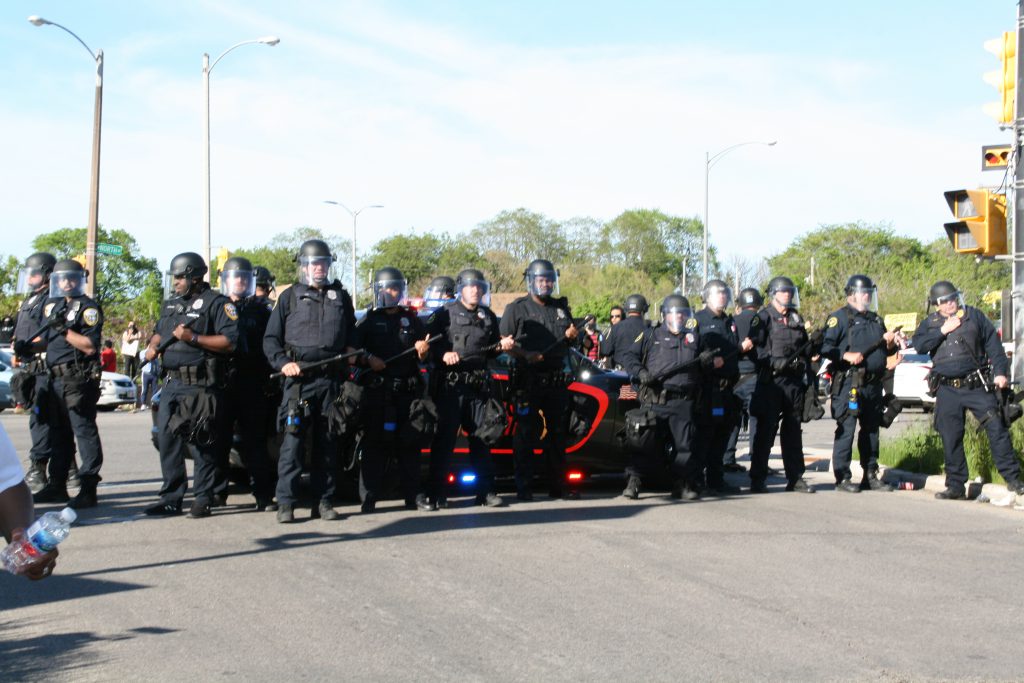Spending on Police Up 30% Since 1986
Study shows municipal governments in state spending far more on policing today.

Milwaukee Police Department officers guard a Sheriff’s vehicle during the June 2020 protests. Photo by Jeramey Jannene.
Those looking to defund police departments will find statistics to justify that push in a new study by the Wisconsin Policy Forum — along with some data that complicates the issue, showing that state spending in this category lags other states.
A new study by the non-partisan Wisconsin Policy Forum finds that municipal governments in Wisconsin spent $219 per capita on law enforcement in 2018, an inflation-adjusted increases of 29.8 percent since 1986 and 6.4 percent since 2000. “Though lower than its peak in 2013, police protection as a share of total municipal spending is higher than in the 1990s and early 2000s and makes up a larger share of total county spending than at any point since 1986,” the study finds.
And that huge increase has come despite a long-term decrease in crime during that period. Major crimes decreased by 54.7 percent since 1986 in Wisconsin, the study noted, which included a 14.3 percent increase in violent crime, with property crimes (which are far more numerous) declining by 59.3 percent.
Milwaukee has been increasing its police budget going back many years, as Urban Milwaukee has reported: Since 2009 the police budget has grown from $171 million to $297 million, up 73.7 percent, while the city budget has grown by just 14.2 percent. Most of that money has gone for increased salary and benefits for police, rather than for increases in sworn police officers. In fact their numbers actually decreased in recent years.
Yet, if the long-term data on law enforcement spending in Wisconsin gives reason to think some cuts in spending might be in order, the study offers a couple caveats regarding the data:
-When local, county and state spending on law enforcement is combined, Wisconsin actually trails other states, spending 3.7 percent of all state and local spending on police protection, compared to 4.0 percent nationwide. That is mostly because Wisconsin ranks dead last in state spending on policing, a remarkable statistic which the study does not venture to explain.
-The huge reduction in crime might reflect other factors including “changes in laws, police reporting practices, and definitions such as that used for sexual assault,” the report suggests. But while that might have an impact on reported crimes (which have decreased by 51 percent since 1993), it would not affect the annual victimization surveys, that ask Americans each year whether they were victims of a crime, and which show a whopping 71 percent decline in crimes since 1993.
The WPF study shows this state fits into a national trend of ever more spending on police. “From 1977 to 2017, state and local government spending on police increased from $42 billion to $115 billion (in 2017 inflation-adjusted dollars),” a study by the Urban Institute found. The study showed that Wisconsin ranked somewhere near the middle in per capita state and local spending on police. That said, the study showed that as a percent of state and local budgets, spending on police hadn’t changed much in those 40 years, perhaps because government spending is driven by personnel costs which have risen steadily, often driven by health insurance costs.
As the debate over such data plays out, the WPF suggests a more important factor that may require cuts in police budgets:
“In the end, however, decisions on whether to reduce police spending may be driven at least as much by fiscal reality than by debating the merits of police ‘defunding.’ Given law enforcement’s large share of overall local government spending in Wisconsin, many of the state’s municipalities may have little choice but to consider cuts or freezes to police spending as their financial challenges intensify from the COVID-19 pandemic.”
If you think stories like this are important, become a member of Urban Milwaukee and help support real, independent journalism. Plus you get some cool added benefits.
More about the 2020 Racial Justice Protests
- Plea Agreement Reached On Long-Pending Sherman Park Unrest Charges Involving Vaun Mayes - Jeramey Jannene - Oct 17th, 2024
- Rep. Ryan Clancy Settles With City Following 2020 Curfew Arrest - Jeramey Jannene - Dec 12th, 2023
- Supervisor Clancy Applauds Settlement in Clancy vs. City of Milwaukee - State Rep. Ryan Clancy - Dec 12th, 2023
- Tosa Protest Assails Federal Court Decision Exonerating Police - Isiah Holmes - May 9th, 2023
- Wauwatosa ‘Target List’ Trial Begins - Isiah Holmes - May 3rd, 2023
- Shorewood Spitter Found Guilty For 2020 Protest Confrontation - Jeramey Jannene - Apr 20th, 2023
- City Hall: City Will Pay 2020 George Floyd Protester $270,000 - Jeramey Jannene - Feb 14th, 2023
- Tosa Protest Tickets Dismissed - Isiah Holmes - Jul 21st, 2022
- Op Ed: ‘We Need More’ - Charles Q. Sullivan - Mar 4th, 2022
- Milwaukee Officers Circulate “2020 Riot” Coins? - Isiah Holmes - Nov 14th, 2021
Read more about 2020 Racial Justice Protests here
Back in the News
-
Eric Hovde Has Another Bad Week
 Apr 22nd, 2024 by Bruce Murphy
Apr 22nd, 2024 by Bruce Murphy
-
Josh Kaul Investigating Fake Electors?
 Apr 17th, 2024 by Bruce Murphy
Apr 17th, 2024 by Bruce Murphy
-
State’s 7 Richest People Worth $72 Billion
![John Menard Jr. Photo by Travisvanvelzen (Own work) [CC BY-SA 4.0 (https://creativecommons.org/licenses/by-sa/4.0)], via Wikimedia Commons](https://urbanmilwaukee.com/wp-content/uploads/2020/09/John_menard_jr-1-e1630092418445-185x122.jpg) Apr 8th, 2024 by Bruce Murphy
Apr 8th, 2024 by Bruce Murphy





















